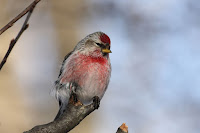COMMON REDPOLL
COMMON REDPOLL – (Acanthis flammea) – (See images below)
DESCRIPTION: The Common Redpoll is a small bird of the finch family. The male has a red forehead and some red washed up on the breast. The conical bill is yellow. The top parts and sides are streaked medium brown, and the under parts are grey. Females are similar but don’t have red on the breast. It is approximately 12 cm (5 inches) long.
VOICE: https://www.xeno-canto.org/species/Acanthis-flammea
NAME: The ‘poll’ part of the English name ‘Redpoll’ refers to a old word for ‘head’. The Latin genus name ‘Acanthis’ means ‘a bird fond of thistles’, in reference to the bird’s diet. As for the Latin species name ‘flammea’, it means ‘flame’.
HABITAT: Coniferous and mixed boreal forest, tundra scrubland, weedy fields.
DIET: Summer- mainly insects and spiders, also tree seeds. Winter – mainly seeds. When feeding on tree seeds, redpolls have the ability of shaking them off the tree, and eating them after they fall on the ground. They also are easily attracted to bird feeders.
NESTING: The nest is usually placed in the lower part of a tree or shrub. An average of five light green eggs are laid, which are incubated by the female. Chicks are fed mostly by the female.
DISTRIBUTION: The common redpoll breeds in the arctic regions of Canada, Europe and Asia. Common redpolls can cross continents when migrating. They are year-round residents south of that range. Their migration grounds include southern Canada and the northern USA, as well as most of Europe and Asia. Some vagrants have reached Hawaii. (See note below for information on bird vagrancy.)
DISTRIBUTION MAP: https://en.wikipedia.org/wiki/Common_redpoll#/media/File:Acanthis_flammea_map.svg
ON PEI: The common redpoll does not breed on Prince Edward Island, and has never been observed in the summer. It is an ‘irruptive’ species, which means it can be uncommon or very common in the fall and winter, depending on food sources.
CONSERVATION: The common redpoll population is estimated at more than 150 million, and the species is not considered at risk.
NOTES: This bird is well equipped to survive a harsh habitat with extra feathers, and can withstand temperatures even lower than minus 40 (C and F). It can also dig a small tunnel in the snow to keep warmer. As with the Blue Jay, the common redpoll also has a throat poach to store seeds for future consumption. Common redpolls forage in flocks in the winter, that can number in the thousands.
Vagrancy: In biology this means an animal going way outside its normal range. For birds, this can happen when there are storms and they get blown off course. On other times, the bird simply wanders in a different direction than usual. Here’s an article about vagrancy in birds.
SIMILAR SPECIES: Pine Siskin, Purple Finch (which is slightly larger), House Finch, Hoary Redpoll – Here’s an article to help distinguish the common redpoll from the hoary redpoll.
REFERENCES: https://www.allaboutbirds.org/guide/Common_Redpoll/lifehistory
http://birdweb.org/birdweb/bird/common_redpoll
https://www.audubon.org/field-guide/bird/common-redpoll
https://en.wikipedia.org/wiki/Common_redpoll
https://www.borealbirds.org/bird/common-redpoll
DESCRIPTION: The Common Redpoll is a small bird of the finch family. The male has a red forehead and some red washed up on the breast. The conical bill is yellow. The top parts and sides are streaked medium brown, and the under parts are grey. Females are similar but don’t have red on the breast. It is approximately 12 cm (5 inches) long.
VOICE: https://www.xeno-canto.org/species/Acanthis-flammea
NAME: The ‘poll’ part of the English name ‘Redpoll’ refers to a old word for ‘head’. The Latin genus name ‘Acanthis’ means ‘a bird fond of thistles’, in reference to the bird’s diet. As for the Latin species name ‘flammea’, it means ‘flame’.
HABITAT: Coniferous and mixed boreal forest, tundra scrubland, weedy fields.
DIET: Summer- mainly insects and spiders, also tree seeds. Winter – mainly seeds. When feeding on tree seeds, redpolls have the ability of shaking them off the tree, and eating them after they fall on the ground. They also are easily attracted to bird feeders.
NESTING: The nest is usually placed in the lower part of a tree or shrub. An average of five light green eggs are laid, which are incubated by the female. Chicks are fed mostly by the female.
DISTRIBUTION: The common redpoll breeds in the arctic regions of Canada, Europe and Asia. Common redpolls can cross continents when migrating. They are year-round residents south of that range. Their migration grounds include southern Canada and the northern USA, as well as most of Europe and Asia. Some vagrants have reached Hawaii. (See note below for information on bird vagrancy.)
DISTRIBUTION MAP: https://en.wikipedia.org/wiki/Common_redpoll#/media/File:Acanthis_flammea_map.svg
ON PEI: The common redpoll does not breed on Prince Edward Island, and has never been observed in the summer. It is an ‘irruptive’ species, which means it can be uncommon or very common in the fall and winter, depending on food sources.
CONSERVATION: The common redpoll population is estimated at more than 150 million, and the species is not considered at risk.
NOTES: This bird is well equipped to survive a harsh habitat with extra feathers, and can withstand temperatures even lower than minus 40 (C and F). It can also dig a small tunnel in the snow to keep warmer. As with the Blue Jay, the common redpoll also has a throat poach to store seeds for future consumption. Common redpolls forage in flocks in the winter, that can number in the thousands.
Vagrancy: In biology this means an animal going way outside its normal range. For birds, this can happen when there are storms and they get blown off course. On other times, the bird simply wanders in a different direction than usual. Here’s an article about vagrancy in birds.
SIMILAR SPECIES: Pine Siskin, Purple Finch (which is slightly larger), House Finch, Hoary Redpoll – Here’s an article to help distinguish the common redpoll from the hoary redpoll.
REFERENCES: https://www.allaboutbirds.org/guide/Common_Redpoll/lifehistory
http://birdweb.org/birdweb/bird/common_redpoll
https://www.audubon.org/field-guide/bird/common-redpoll
https://en.wikipedia.org/wiki/Common_redpoll
https://www.borealbirds.org/bird/common-redpoll
 |
| Common Redpoll, male, Cap Tourmente National Wildlife Area, Quebec, © Cephas |